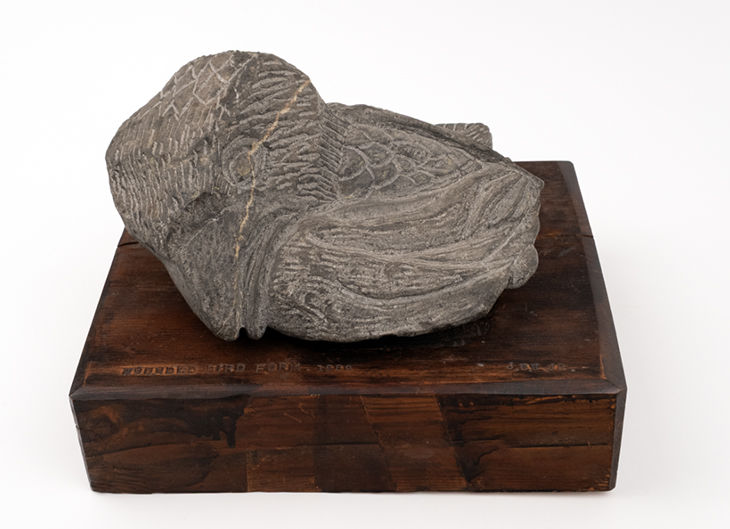James W. Washington, Jr., “Many Hats, One Spirit”
- Democracy Chain

- Aug 12
- 4 min read
Updated: Aug 18
by Matthew Kangas
Bainbridge Island Museum of Art, Bainbridge Island, Washington
Continuing to September 17, 2026

One of the factors that makes assessing James W. Washington, Jr.’s contribution to America’s art history difficult is his multifarious life, which spanned the 20th century. His interests embraced social activism, religious conviction, and an ancillary role in the Northwest School of art (best known for its four principals, Guy Irving Anderson, Kenneth Callahan, Morris Graves, and Mark Tobey). In this retrospective, curator Greg Robinson simplifies the historic task by focusing on a limited number of works, but also complicates it by including a plethora of biographical memorabilia. Meanwhile, Washington’s posthumous influence can be seen through the artist-in-residency program at his former home in Seattle. There is plenty to absorb and contemplate.
His youth and early manhood were spent in Jim Crow Mississippi, where he initially worked as a cobbler. The fourth of a Baptist minister’s six children, he worked as an art instructor during the Great Depression under the Works Progress Administration. Washington curated the first all-Black WPA exhibit in the state; another WPA show there excluded Blacks.

The second, and more significant, half of his life began in 1944 when he moved to Seattle, attracted by defense jobs. There he worked as an electrician at the Bremerton Navy Yard. Following the war’s end, Washington attracted the attention of Tobey, who saw his paintings in a show at a downtown department store. He subsequently studied privately with Tobey. The exhibition includes numerous examples of his Seattle-era paintings, most of which are recollections of the Deep South. A few works address wartime issues. It was in these works that Washington reached an individual maturity which eventually led to his best-known works, carved stone sculptures of animals.
The paintings, in particular “Democracy Challenged” (1949) and “Making of the United Nations Charter” (1945), look more timely than ever. They are simultaneously explicit and symbolic images, featuring lynchings and ropes in the former work and eerie bayonets, skeletal hands, and pertinent newspaper clippings in the latter.

Other paintings depict Seattle and other cities, notably “Viaduct (Vicksburg, MS)” (1938); “Rummage Sale (Pike Place Market)” (1952); “Wight Avenue and High Street (Little Rock)” (1942); and “Mexico City Market #2” (1951). Other paintings, such as a series on Black cowboys, are sadly missing, as they would have presented Washington’s chronicles of African American life even more expansively.
It was in Mexico, at the base of a pyramid, that the artist achieved what he called his “epiphany,” which led to his shift to carving stone sculpture. Picking up a piece of lava stone, he had a spiritual vision of the life within the stone. Upon returning to Seattle, Washington embarked on a long series of forlorn birds, which he was already painting (perhaps under Graves’ influence), and figurative heads. The heads range from seminal Black leaders such as Martin Luther King, Jr. (not on view) and Kenya’s first elected president Jomo Kenyatta, to biblical personages such as “Simon of Syrene” (1961) and “Abraham’s Father and Torah” (1989).
Among the birds, “Phoenix Offering Itself on Altar” (1989) is the most abstract, with its charred lava stone midway between death and fiery resurrection. Others combine hieroglyphic inscriptions that refer to the artist’s membership in the Freemasons. “Field Bird” (1966), “Wounded Eagle #10” (1963), and “Bird on Nest” (1960) capture the emerging forms of life in the rigid granite.

More varied and allusive, “Eve’s Friend” (1970) depicts the Garden of Eden serpent wrapped around a female figure, while “Kingdom of God Within You” (1974) combines human and animal images, including a pregnant woman, slowly converging within the rock. By the late 1980s, Washington’s stature was secure, but it was left to Paul J. Karlstrom, a Smithsonian Institution scholar with a specialty in art of the Pacific Coast, to place the artist in the wider context of American art, comparing him to William Edmondson and William Zorach.

As to the artists-in-residence at the Washington home (now being restored), 27 out of 48 are represented in the exhibition. Among them, a vivid abstract painting by Romson Regarde Bustillo, “Lightning (What Becomes of Sorrow)” (2020) commands the side gallery, joined by photo-transferred dye-on-aluminum passport photographs of relatives by MalPina Chan. While the selection is highly varied in both style and material, one work, “Lift Every Voice and Sing” by Christen Mattix, best echoes the older artist’s themes: a large black-and-white image of Dr. King is composed of affixed, stacked hardbound books that symbolize knowledge of the past and present, a fitting tribute to the slain leader and the revered sculptor.
Matthew Kangas writes regularly for Visual Art Source eNewsletter; Ceramics: Art & Perception (Australia); and Preview (Canada). Besides reviewing for many years at Art in America, American Craft, Art Ltd., Vanguard and Seattle Times, he is the author of numerous catalogs and monographs, the latest being the award-winning Italo Scanga 1932-2001. Four anthologies of his critical essays, reviews and interviews were issued by Midmarch Arts Press (New York) and available on Amazon at Books by Matthew Kangas.





Comments